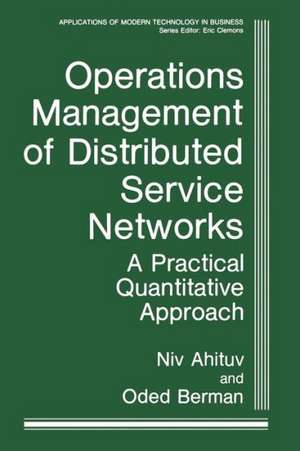Operations Management of Distributed Service Networks: A Practical Quantitative Approach: Applications of Modern Technology in Business
Autor Niv Ahituv, Oded Bermanen Limba Engleză Paperback – 23 dec 2011
Preț: 388.13 lei
Nou
Puncte Express: 582
Preț estimativ în valută:
74.28€ • 77.26$ • 61.32£
74.28€ • 77.26$ • 61.32£
Carte tipărită la comandă
Livrare economică 14-28 aprilie
Preluare comenzi: 021 569.72.76
Specificații
ISBN-13: 9781461282815
ISBN-10: 1461282810
Pagini: 312
Ilustrații: 310 p.
Dimensiuni: 152 x 229 x 16 mm
Greutate: 0.42 kg
Ediția:Softcover reprint of the original 1st ed. 1988
Editura: Springer Us
Colecția Springer
Seria Applications of Modern Technology in Business
Locul publicării:New York, NY, United States
ISBN-10: 1461282810
Pagini: 312
Ilustrații: 310 p.
Dimensiuni: 152 x 229 x 16 mm
Greutate: 0.42 kg
Ediția:Softcover reprint of the original 1st ed. 1988
Editura: Springer Us
Colecția Springer
Seria Applications of Modern Technology in Business
Locul publicării:New York, NY, United States
Public țintă
ResearchCuprins
1 Distributed Service Network Characteristics.- 1.1. What Is a Distributed Service Network?.- 1.2. Hierarchy of Policy Making in a Distributed Service Network.- 1.3. Technical Characteristics of a Distributed Service Network.- 1.4. The Hypercube Model: A System in a Steady State.- 1.5. Mathematical Presentation.- Key Concepts.- References.- 2 Zoning.- 2.1. What is Zoning?.- 2.2. Zoning Criteria.- 2.3. A Zoning Selection Process.- 2.4. Mathematical Section.- Key Concepts.- References.- 3 Location of Stationary Facilities.- 3.1. Classification of Location Problems.- 3.2. The One-Median Problem.- 3.3. The p-Median Problem.- 3.4. The One-Center Problem.- 3.5. The p-Center Problem.- 3.6. The Requirements Problem.- 3.7. The Stochastic One-Median Problem.- 3.8. Mathematical Presentation.- Key Concepts.- References.- 4 Allocation of Service Resources.- 4.1. Introduction.- 4.2. Answering Telephone Calls.- 4.3. Allocating Servers to a Station.- 4.4. Employing Reserve Units.- 4.5. Allocation of Units among a Number of Service Stations.- 4.6. Staffing a Service Unit.- 4.7. Mathematical Section.- Key Concepts.- References.- 5 Dispatching.- 5.1. Definition and Classification of Dispatching-Related Concepts.- 5.2. Cooperation in a Congested Network.- 5.3. No Cooperation in a Congested Network.- 5.4. Dispatching Criteria in a Noncongested Network.- 5.5. Dispatching Moving Servers in a Noncongested Network.- 5.6. Mathematical Presentation.- Key Concepts.- References.- 6 Repositioning.- 6.1. Reasons, Costs, and Benefits of Repositioning.- 6.2. Location on a Stochastic Network.- 6.3. Repositioning on a Stochastic Network.- 6.4. Repositioning in Congested Networks.- 6.5. Mathematical Presentation.- Key Concepts.- References.- 7 Patrol Routing.- 7.1. The Difference between Routing and Patrol Routing.- 7.2. A Patrol Routing Problem.- 7.3. A Model with Constraints on the Number of Nodes to be Visited.- 7.4. A Model with a Constraint on Travel Time.- 7.5. Mathematical Presentation.- Key Concepts.- References.- 8 Selecting an Information System for Dispatching Decisions.- 8.1. Alternative Information Systems.- 8.2. Stationary Information System (SIS).- 8.3. Check-in Information System (CIS).- 8.4. Real-Time Information System (RIS).- 8.5. The Value of the Information System.- 8.6. Mathematical Presentation.- Key Concepts.- References.- 9 Negotiating Cooperation between Adjacent Service Networks.- 9.1. The Benefits and Limitations of Cooperation.- 9.2. Cooperation in the Case of a Zero Capacity Queue.- 9.3. Charging for Rendered Service.- 9.4. Mathematical Presentation.- Key Concepts.- References.- 10 A Comprehensive Approach to Cooperation.- 10.1. Introduction.- 10.2. Analysis of Sample Networks.- 10.3. Allowing for Nonpure Decisions.- 10.4. Applying the Model—Sample Numerical Results.- 10.5. Sensitivity of the Cooperation Policy to Penalty Values and Travel Times.- 10.6. Some Concluding Remarks.- 10.7. Mathematical Presentation.- Key Concepts.- References.























